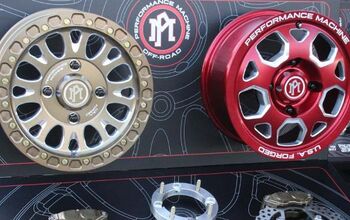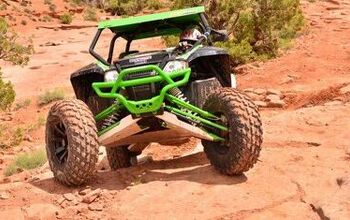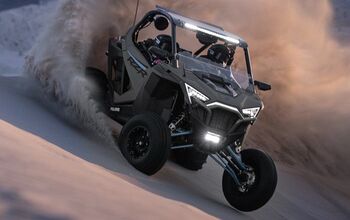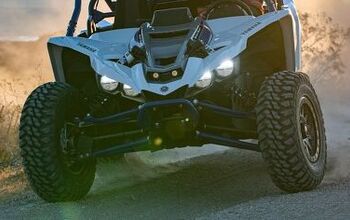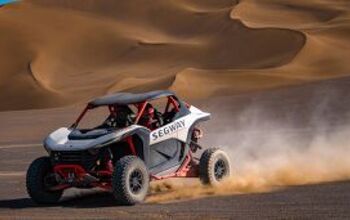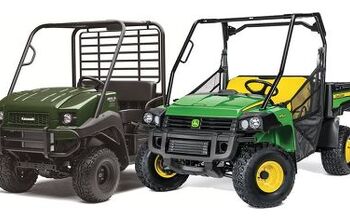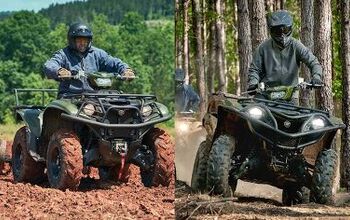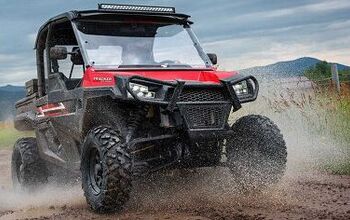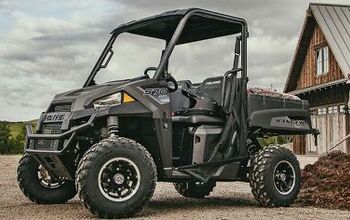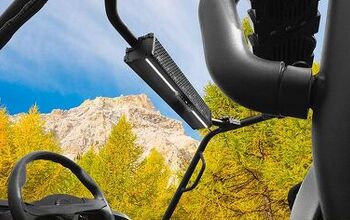Maxxis Bighorn Tires for ATVs and UTVs
Ever wonder why so many machines come standard with these tires
Maxxis Bighorn tires have a stellar reputation in the off-road world and are used as stock tires on many machines. Here’s why.
If you look at the tires many manufacturers choose to run as the stock tire on the recent crop of UTVs, the number-one choice is a variation of the Maxxis Bighorn. The tire has won races and championships across multiple forms of competition and is a proven tire option. What makes this the tire of choice? It’s a couple of things, really. While new tire designs are always in the works, the Bighorn will remain a strong favorite and with good reason.
One of the biggest reasons for the success of the tire is the non-directional tread pattern. A mix of knobs and bars highlights the footprint of the tire. It has enough open space to clean up from mud. Wrap around tread on the sidewalls give extra traction in ruts and rocks, too. The profile of the tire is semi-flat, giving the Bighorn a wide footprint. This makes the tire a good choice for desert, rocks, and most dirt situations. While not an ideal mud tire, compared to the specialized tire for that application, the Bighorn will hold its own in the slop, too.
Table of Contents
-
1. Maxxis Bighorn 1.0: Shop Now
-
2. Maxxis Bighorn 2.0: Shop Now
-
3. Maxxis Bighorn 3.0: Shop Now
-
4. Maxxis Bighorn Review: Shop Now
-
5. How Much Do Maxxis Bighorns Weigh?: Shop Now
-
6. Maxxis Bighorn Alternative #1: Sedona Rip-Saw: Shop Now
-
7. Maxxis Birhorn Alternative #2: ITP Blackwater Evolution: Shop Now
1. Maxxis Bighorn 1.0
There are currently three variations of the Maxxis Bighorn tire on the market. The Maxxis Bighorn Radial is a 6-ply, radial tire. It can be found for 12-, 14- and 15-inch rim sizes and comes in both front and back versions. You can find a set for your very own at dealers near you, or online.
2. Maxxis Bighorn 2.0
The Maxxis Bighorn 2.0 Radial is a lighter-weight version of the Bighorn. This may well be the most popular version of the tire. Maxxis reduced the weight of the tire by making the bars in the tread a little slimmer and a little shallower. Like the Bighorn, it is a 6-ply tire. It is available in 12-inch and 14-inch rim sizes. It has a front and rear model, to completely cover your machine’s needs. Being that is uses a little less rubber, the Maxxis Bighorn 2.0 tires tend to run a little less money.
3. Maxxis Bighorn 3.0
The Maxxis Bighorn 3.0 Radial is the latest version of the legendary tire. It has an all-new tread pattern that is based on the original. The front version is directional, while the rear keeps the non-directional pattern going. The tread is a little closer packed to increase the smooth ride and some sipping in the tread blocks adds grip in rocky terrain and on other slick surfaces. The goal for the 3.0 is to increase grip while retaining the legendary versatility and large contact patch the Maxxis Bighorn is known for. The 3.0 is also a 6-ply tire and it also comes in 12-inch and 14-inch rim sizes. Be prepared for a serious boost in traction with these tires! They are really that good. Go see your local tire guy, but you might want to get them online, instead.
4. Maxxis Bighorn Review
A while ago, I was sitting in a new machine briefing as the company was going over its latest UTV and why it was made the way it was. When it came to the tires, the product manager simply said, “We ran the Maxxis Bighorns on it because we hate flat tires as much as you do.” Can you get a flat in a Maxxis Bighorn? Yes. In fact, I’ve done it. But it isn’t easy. My one experience with a flat came in Moab while I was traversing down a rutted trail. I picked the wrong line and ended up with a pinch flat. I can’t blame the tire for my driving.
I know a guy who raced the Baja 1,000 who said they used one set of Maxxis Bighorn tires for the whole race. He then added that the tires were in good enough shape after the race that he used them in a different race a few months later, and then used them on one of his personal machines for trail riding for a few years. The rubber compound wears really slow and the sidewall tread protects from punctures, unless you’re driving like a goon and get a pinch flat in Moab.
You can find Maxxis Bighorns on so many stock ATVs and UTVs for a reason. These are some of the best all-purpose tires in the industry.
We’ve relied on Maxxis Bighorn ATV tires and UTV tires for everything from rock crawling, fast trail riding, slogging through light mud and even dune riding. You will certainly get better results with terrain-specific tires for rock crawling, mud riding and dune riding, but few tires are as capable on a variety of terrain as the Maxxis Bighorn.
If you are the type of rider that wants one tire that is serviceable in just about any condition, the original Maxxis Bighorn tires, along with the Maxxis Bighorn 2.0 and Maxxis Bighorn 3.0 are well worth checking out.
5. How Much Do Maxxis Bighorns Weigh?
As there are three different Maxxis Bighorn tires available – the Original Bighorn, along with the Maxxis Bighorn 2.0 and 3.0 – answering the question of how much do Maxxis Bighorns weigh is complicated.
The original Maxxis Bighorn and the Bighorn 3.0 are, for the most part, about the same weight. It’s really just the tread design that sets these tires apart, along with a slightly firmer compound on the 3.0 with what Maxxis calls better wear characteristics. The Maxxis Bighorn 2.0, meanwhile, is built to be a bit lighter to shave down the rotating mass.
Below is a chart with approximate weights for comparable sizes of the three Maxxis Bighorn tires.
| Approximate Weight | |||
| Size | Bighorn | Bighorn 2.0 | Bighorn 3.0 |
| 26x9R12 | 24 LBS | 22 LBS | 25 LBS |
| 26x9R14 | 24 LBS | 22 LBS | 24 LBS |
| 26x11R14 | 28 LBS | 27 LBS | 28 LBS |
| 29x9R14 | 26 LBS | 25 LBS | 27 LBS |
| 29x11R14 | 32 LBS | 30 LBS | 31 LBS |
6. Maxxis Bighorn Alternative #1: Sedona Rip-Saw
The Sedona Rip-Saw is one of our favorite all-around tires. Like the Bighorn, the Rip-Saw is a Jack of all trades. It is built with a 6-ply rated carcass and sports semi-aggressive 1 1/8" lugs. The treads are spaced out enough that they perform admirably in mud (we'd suggest a better than the Bighorn) and the treads are siped for added traction on wet surfaces.
Those more aggressive lugs on the Rip-Saw are not quite as smooth running on hard-pack trails as the Bighorn, but the difference is fairly small. In our opinion, if you mostly ride on hard-pack terrain, the Bighorn is probably the winner. But if you like to play in the mud and don't want to commit to a super aggressive tire, the Sedona Rip-Saw is a great option.
7. Maxxis Birhorn Alternative #2: ITP Blackwater Evolution
Compared to the Bighorn, the ITP Blackwater Evolution has a more rounded profile - particularly in the rear tires. That profile, combined with the irregular tread pattern, makes the Blackwater Evolution a little more adept in muddy conditions.
The ITP Blackwater Evolution is also a heavier tire, as it uses a more robust 8-ply carcass. You will lose a little power as the engine has to work harder to move the heavier rubber, but the benefit is a superbly tough tire that an stand up to a whole lot of trail abuse.
Recent Updates
April 23, 2021: Added the Sedona Rip-Saw and ITP Blackwater Evolution as possible alternatives to the Bighorn.
Become an ATV.com insider. Get the latest news first by subscribing to our newsletter here.
We are committed to finding, researching, and recommending the best products. We earn commissions from purchases you make using the retail links in our product reviews. Learn more about how this works.
Derrek's love for all things ATV started when he was a mere 11 years old, growing up on his family farm. His mom gave him and his sister a choice - get a horse, or a three-wheeler. The sister wanted the horse, and Derrek wanted the ATV. Luckily he won out, and was soon burning up the trails on a Yamaha Tri-Moto 200. By the time he was 14, he had saved enough of his own money by working on the farm and in his folks restaurant to buy a new 4-wheeler. That happened the day he and his mom were driving past the dealership and saw 1987 Banshee. His mom had no idea what he was buying, and he never looked back. He's been riding ever since, and been writing professionally for many years. He has ridden all over North America and been behind the controls of just about every machine out there. And yes, he still has his 1987 Yamaha Banshee.
More by Derrek Sigler


















